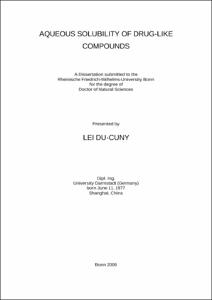Du-Cuny, Lei: Aqueous solubility of drug-like compounds. - Bonn, 2006. - Dissertation, Rheinische Friedrich-Wilhelms-Universität Bonn.
Online-Ausgabe in bonndoc: https://nbn-resolving.org/urn:nbn:de:hbz:5N-07448
Online-Ausgabe in bonndoc: https://nbn-resolving.org/urn:nbn:de:hbz:5N-07448
@phdthesis{handle:20.500.11811/2610,
urn: https://nbn-resolving.org/urn:nbn:de:hbz:5N-07448,
author = {{Lei Du-Cuny}},
title = {Aqueous solubility of drug-like compounds},
school = {Rheinische Friedrich-Wilhelms-Universität Bonn},
year = 2006,
note = {New effective experimental techniques in medicinal chemistry and pharmacology have resulted in a vast increase in the number of pharmacologically interesting compounds. However, the possibility of producing drug candidates with optimal biopharmaceutical and pharmacokinetic properties is still improvable. A large fraction of typical drug candidates is poorly soluble in water, which results in low drug concentrations in gastrointestinal fluids and related acceptable low drug absorption. Therefore, gaining knowledge to improve the solubility of compounds is an indispensable requirement for developing compounds with drug-like properties.
The main objective of this thesis was to investigate whether computer-based models derived from calculated molecular descriptors and structural fragments can be used to predict aqueous solubility for drug-like compounds with similar structures. For this purpose, both experimental and computational studies were performed. In the experimental work, a novel crystallization method for weak acids and bases was developed and applied for European patent. The obtained crystalline materials could be used for solubility measurements. A novel recognition method was developed to evaluate the tendency of compounds to form amorphous forms. This method could be used to ensure that only solubilities of crystalline materials were collected for the development of solubility prediction. In the development of improved in silico solubility models, lipophilicity was confirmed as the major driving factor and crystal information related descriptors as the second important factor for solubility. Reasons for the limited precision of commercial solubility prediction tools were identified. A general solubility model of high accuracy was obtained for drug-like compounds in congeneric series when lipophilicity was used as descriptor in combination with the structural fragments. Rules were derived from the prediction models of solubility which could be used by chemists or interested scientists as a rough guideline on the contribution of structural fragments on solubility: Aliphatic and polar fragments with high dipole moments are always considered as solubility enhancing. Strong acids and bases usually have lower intrinsic solubility than neutral ones. In summary, an improved solubility prediction method for congeneric series was developed using high quality solubility results of drugs and drug precursors as input parameter. The derived model tried to overcome difficulties of commercially available prediction tools for solubility by focusing on structurally related series and showed higher predictive power for drug-like compounds in comparison to commercially available tools. Parts of the results of this work were protected by a patent application1, which was filed by F. Hoffmann-La Roche Ltd on August 30, 2005.},
url = {https://hdl.handle.net/20.500.11811/2610}
}
urn: https://nbn-resolving.org/urn:nbn:de:hbz:5N-07448,
author = {{Lei Du-Cuny}},
title = {Aqueous solubility of drug-like compounds},
school = {Rheinische Friedrich-Wilhelms-Universität Bonn},
year = 2006,
note = {New effective experimental techniques in medicinal chemistry and pharmacology have resulted in a vast increase in the number of pharmacologically interesting compounds. However, the possibility of producing drug candidates with optimal biopharmaceutical and pharmacokinetic properties is still improvable. A large fraction of typical drug candidates is poorly soluble in water, which results in low drug concentrations in gastrointestinal fluids and related acceptable low drug absorption. Therefore, gaining knowledge to improve the solubility of compounds is an indispensable requirement for developing compounds with drug-like properties.
The main objective of this thesis was to investigate whether computer-based models derived from calculated molecular descriptors and structural fragments can be used to predict aqueous solubility for drug-like compounds with similar structures. For this purpose, both experimental and computational studies were performed. In the experimental work, a novel crystallization method for weak acids and bases was developed and applied for European patent. The obtained crystalline materials could be used for solubility measurements. A novel recognition method was developed to evaluate the tendency of compounds to form amorphous forms. This method could be used to ensure that only solubilities of crystalline materials were collected for the development of solubility prediction. In the development of improved in silico solubility models, lipophilicity was confirmed as the major driving factor and crystal information related descriptors as the second important factor for solubility. Reasons for the limited precision of commercial solubility prediction tools were identified. A general solubility model of high accuracy was obtained for drug-like compounds in congeneric series when lipophilicity was used as descriptor in combination with the structural fragments. Rules were derived from the prediction models of solubility which could be used by chemists or interested scientists as a rough guideline on the contribution of structural fragments on solubility: Aliphatic and polar fragments with high dipole moments are always considered as solubility enhancing. Strong acids and bases usually have lower intrinsic solubility than neutral ones. In summary, an improved solubility prediction method for congeneric series was developed using high quality solubility results of drugs and drug precursors as input parameter. The derived model tried to overcome difficulties of commercially available prediction tools for solubility by focusing on structurally related series and showed higher predictive power for drug-like compounds in comparison to commercially available tools. Parts of the results of this work were protected by a patent application1, which was filed by F. Hoffmann-La Roche Ltd on August 30, 2005.},
url = {https://hdl.handle.net/20.500.11811/2610}
}






